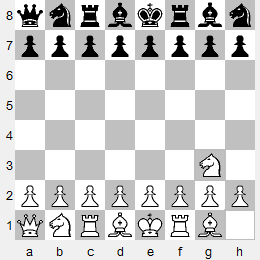Black must have been very surprised when his opponent replied 2.Nh5, attacking the Pawn on g7, a Pawn which cannot be defended. Even worse, the Knight move threatens smothered mate. Black answered 2...f6, along with the comment, 'Ugly starting position and I bungled it.' It's like giving odds of Pawn and move.

SP301 QNRBKRBN
What should Black have played in response to 1.Ng3? One idea is 1...f6, opening the diagonal for the Bg8. If then 2.Nh5, Black has 2...g6, and if White continues 3.Ng7+, the Knight is trapped after 3...Kf7. Another idea is 1...b6, with a counterattack on White's g2. The obvious move is 1...g6, preventing the White Knight from going to either f5 or h5, but I don't like this move because it does nothing for Black's development and takes the natural square from the Knight on h8.
A little thought convinced me that any position starting ****KRBN is susceptible to the same tactic. How many such positions are there? Since the remaining White Bishop must be placed on one of the two light squares, when the other three pieces can then be placed on any empty square, there are 2 x 3 x 2 = 12 positions. The same tactic is possible for any twin of those 12 positions, i.e. the positions starting NBRK****, although these have the additional possibility of castling 1...O-O-O.
How do the CCRL engines (see the right sidebar for a link) handle SP301? Of the 82 games currently archived there, White opened 1.Ng3 in 63 of them. The following table shows how many times Black responded with various moves:-
1...f6 x 34
1...f5 x 16
1...g6 x 5
1...b6 x 3
1...e6 x 3
1...e5 x 2
The move 1...f6 is the overwhelming favorite, followed by the surprising 1...f5. It's no surprise, however, that the unfortunate 1...Ng6 was not selected by any of the engines.

1 comment:
Thanks for the nice example Mark! I've contemplated it over at:
http://chess960jungle.blogspot.com/2011/05/chess960-sp301-extreme-test-on-opening.html
Harry
Post a Comment